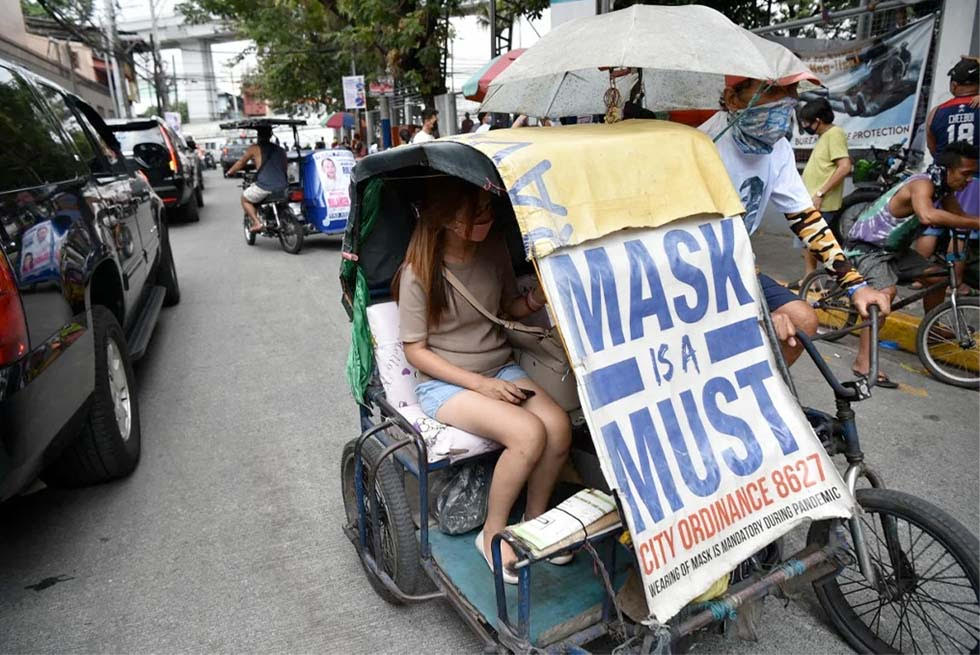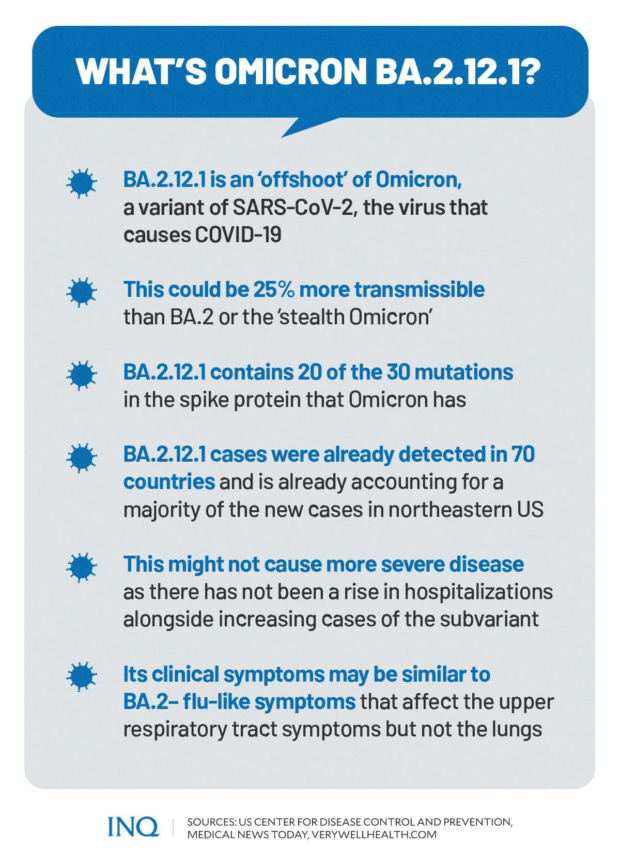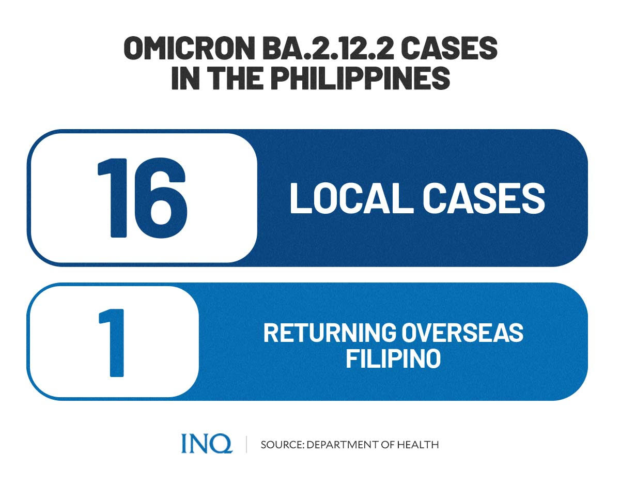Omicron BA.2.12.1 in PH: What you need to know

FILE PHOTO: A passenger sits inside a tricycle covered with a reminder to wear a mask, part of COVID-19 health protocols, in Manila in February. AFP
MANILA, Philippines—Less than three months since the Philippines relaxed its restrictions to Alert Level 1, the Department of Health (DOH) confirmed the local transmission of BA.2.12.1, a more contagious version of Omicron, a variant of SARS-CoV-2, the virus that causes COVID-19.
This, as Health Undersecretary Maria Rosario Vergeire said on Tuesday (May 17) that new BA.2.12.1 cases are no longer related to cases outside the Philippines. She stressed, however, that there is no community transmission yet: “The linkages of the detected cases can still be seen.”
The confirmation came a few days since the DOH said that “it’s too early for us to say that there is local transmission” despite the detection of the sub-variant in two individuals in Metro Manila who did not have a history of travel outside the Philippines.
READ: DOH: Too early to say there is local transmission of Omicron subvariant
What is BA.2.12.1?
Last Jan. 20, the DOH said that Omicron, which was first reported in South Africa on Nov. 24, 2021, is already the dominant COVID variant in the Philippines. Last March, it said the results of the latest genome sequencing showed that 85.9 percent of 568 samples tested positive for the variant.
RELATED STORY: Omicron: What science knows so far about latest Greek-lettered COVID variant
Then last Jan. 27, the DOH said it has detected the BA.2 sub-variant or the “stealth Omicron,” saying that the earliest detection was on Dec. 31, 2021. The sub-variant, the Medical News Today (MNT) said, was known to have 53 mutations compared to the original virus.
Article continues after this advertisementIt said 29 of the 53 mutations were in the spike protein, which helps attach the virus to human cells. “This led to an increased ability to transmit from person to person,” the MNT said.
Article continues after this advertisementThen the BA.2 created its own sub-lineage, the BA.2.12.1, which was already responsible for 48 percent of new COVID-19 cases in the United States last week, according to US Centers for Disease Control and Prevention (CDC).
While there is no evidence yet that the sub-variant causes more severe disease, experts said it is 25 percent more transmissible than BA.2, the dominant version of Omicron in the Philippines and the rest of the world.
The verywellheath.com stressed that in the US, the BA.2.12.1 “is on track to overtake BA.2,” especially with its “transmission advantage,” saying that it was already detected in 70 countries.
“Omicron has continued to evolve and splinter into a smattering of sub-variants that have become more transmissible, and experts believe that more new versions of Omicron may crop up in coming months,” it said.
It stressed that with each evolution of COVID, the virus tends to become “incrementally transmissible than the last version”. It said Omicron has 30 mutations in the spike protein—BA.2.12.1 contains 20 of these.
The spike proteins of COVID-19 targets ACE2 receptors, which allows the virus to access a person’s cells: “Since Omicron’s mutated spike protein is more eager to attach to the ACE2 receptors right when it enters the body, the infection remains largely in the upper respiratory tract and doesn’t always get a chance to move deeper into the lungs.”
Benjamin tenOever (PhD), a professor of microbiology and medicine at the New York University and an affiliate of the New York Genome Center, told verywellhealth.com that the enhancement of the spike protein in Omicron’s sub-variants indicates that these versions may only cause mild illness.
The MNT said that, as stressed by Prof. Elizabeta Mukaetova-Ladinska of the University of Leicester in the United Kingdom, the clinical symptoms of BA.2.12.1 may be similar to BA.2.
She said that in most people, this would mean flu-like symptoms that affect the upper respiratory tract but not the lungs.
According to the DOH, scientists are still characterizing this Omicron sub-lineage in terms of transmissibility and ability to cause more severe disease. Preliminary data have shown that their mutations are associated with higher transmissibility and ability to evade immune response.
But currently available evidence does not suggest changes in disease severity or clinical manifestations.
However, while Dr. Fady Youssef, a board certified pulmonologist, internist and critical care specialist in California told MNT that so far, the sub-variant does not seem to cause a more severe disease than Omicron, “we need further data before we can definitively say”.
BA.2.12.1 cases in PH
The DOH said that to date, the Philippines has a total of 17 BA.2.12.1 cases—16 are local cases while one is a returning overseas Filipino (ROF) from the US.
It was on May 13 when the DOH said that BA.2.12.1 was first detected in two local cases from Metro Manila who had no international travel history. Both cases had mild symptoms and tested positive last April 22.
The two, who are now asymptomatic and have completed isolation, have been fully vaccinated.
Twelve other cases were likewise detected—11 foreign nationals and one local case—from a tourist cluster in Palawan. These individuals went there for a diving exploration on April 23, 2022, however, three days after departure, one of the foreigners experienced nasal congestion.
READ: New Omicron subvariant detected in 11 foreigners, 3 Filipinos
The DOH said one local and three other foreigners developed mild symptoms one to two days after the 15 tested positive in RT-PCR when they arrived at the port on April 29. Only 12 samples were eligible for whole genome sequencing and all came back positive for BA.2.12.1.
“All cases are currently asymptomatic and have been discharged from facility isolation. All were fully vaccinated. Their 28 close contacts from the ship have tested negative and have completed quarantine,” the DOH said.
Then on May 17, the DOH said three cases of BA.2.12.1 have been detected in Western Visayas: one vaccinated returning Filipino from the US, and two are local cases—one of them is vaccinated while the vaccination status of the other is still for verification.
READ: DOH detects 3 more cases of Omicron subvariant BA.2.12.1
DOH strengthening 4-door strategy
With the confirmation of local transmission, Vergeire said local government units are now intensifying the 4-Door Strategy to prevent further transmission of the virus.
The 4-Door Strategy is a national government-enabled, local government-led, and people-centered response to help mitigate the spread of COVID-19 and prepare for a possible rise in cases:
- Door 1: Implementing travel restrictions and bans as a separate and primary level of defense to supplement the currently implemented health protocols.
- Door 2: Ensuring safeguards are implemented–screening, testing, and quarantine at points of entry to lessen the risk of incoming travelers from triggering the local spread of the variants of concern.
- Door 3: Strengthening the implementation of the Prevent-Detect-Isolate-Treat-Reintegrate strategies to immediately detect and isolate possible COVID-19 cases.
- Door 4: Strengthening health and critical capacity and systems against a rise in cases to ensure proper and timely COVID-19 management and continuity of essential services.
Vaccines still a defense?
Dr. David Cutler, a family medicine specialist in California, told MNT that it is not clear why cases are rising in the US where 48 percent of new COVID-19 cases last week are BA.2.12.1.
“Is it because of BA.2.12.1? Is it because people are not wearing masks? Is it because immunity from prior vaccines is waning? These are just some of the unknowns raised by any new variant,” he said.
In the Philippines, the DOH told the public that COVID vaccines are safe and effective against the BA.2.12.1 and they help keep the health care utilization low and the economy reopening on Alert Level 1.
However, it said that should a variant of concern enter the country, expert projections indicate a possible rise and peak in COVID-19 cases, especially with the currently low booster coverage among the eligible population.
“Everyone eligible for a booster shot is highly encouraged to get the jab done, as immunity is proven to wane over time,” the DOH said.
Last Wednesday (May 18), those eligible may now avail themselves of their second booster shot against COVID-19.
READ: Frontliners, elderly may now avail 2nd COVID-19 booster shot – DOH
This came following the recommendation of the Health Technology Assessment Council and after the Food and Drug Administration earlier granted emergency use authorization on the administration of the second COVID vaccine booster to senior citizens and frontline health care workers aged 18 and above.
As of Tuesday (May 17), the Philippines already administered 148,475,731 doses of COVID vaccines—66,173,808 for first dose, 68,769,423 for complete dose and 13,674,611 for booster dose.
RELATED STORIES:
PH logs 103 new COVID-19 cases, active down to 2, 241
DOH wary of Omicron variant surge
TSB
For more news about the novel coronavirus click here.
What you need to know about Coronavirus.
For more information on COVID-19, call the DOH Hotline: (02) 86517800 local 1149/1150.
The Inquirer Foundation supports our healthcare frontliners and is still accepting cash donations to be deposited at Banco de Oro (BDO) current account #007960018860 or donate through PayMaya using this link.



